12th January, 2016: Some Updates and a Realisation
As I was reading some older blog posts this evening before moving some to the Blog Archive, I remembered I had noted HTTPS connection issues under Windows 2000 and IE6, SP1. It turns out this is caused by the SSL or TLS layers using the older SHA-1 encryption method. If you switch this off, it may or may not work. This feature can be turned off under Windows XP, although I think the issue still presents itself every so often. (MSFN Link A, Link B)
Using IE5.5 apparently solves this issue.
Getting onto my favourite topic: WEBSERVERS!
I must ask, however... Can you blame me for NOT liking them at present?
Rather unfortunately, a power outage took out the server and thus the virtual machine running within (the webserver). It turns out you can't "just restore" from a saved virtual machine file, unless you like Blue Screens of Death. Yeah - I found out the hard way, with 200 days of uptime. *Inserts very angry emoji right here*.
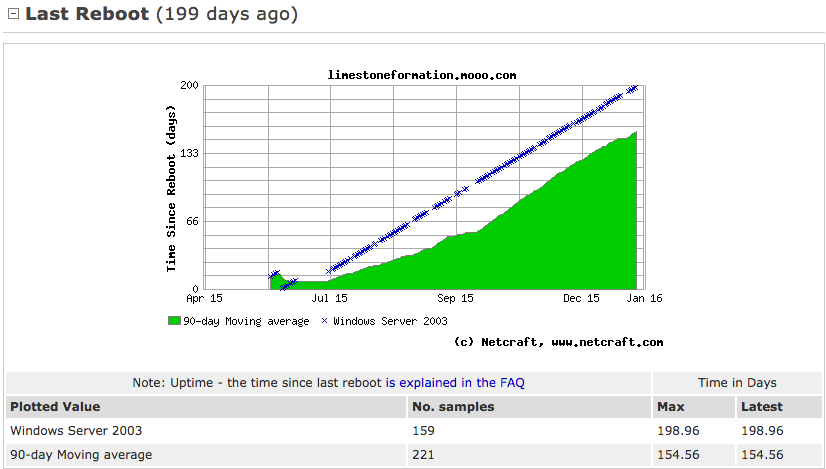

This also lead to me finding out the Webserver's main "access" user account had corrupted itself some time during those intervening 200 days. *Inserts another very angry emoji right here*
Nevertheless, the show MUST go on! Thus the Webserver is still happily chugging away, as is the Server itself - which recently scared me with the Parity drive in my RAID-1 array, once again, orphaning itself. Thankfully, it turns out the RAID card had deseated itself somehow (I assume the worker ants, spiders and other assorted dead insects and arachnids worked some magic). The RAID array subsequently rebuilt itself without any qualms and things are proceeding quite nicely.
For the record, my boot drive now has over 45,000hrs on it. Lets see how long it can hold the Sea behinds it's Gates - *cringes at the bad pun he just made.*
Unfortunately, I did spy what appeared to potentially be a bloated or popped capacitor. There was grey stuff on top and the top did appear bulged. However, given the amount of bugs that get into the Server, it could just be their "leavings," for lack of a worse way to put it.
As I said before, the show MUST go on. Therefore, contrary to what had been suggested prior, my Webserver WILL NOT be going offline. Instead, it will be mirrored somehwere within the realms of the ever-Ghostly, GREYGHOST. (Does it still sound scary? Good). I must say, I am exceedingly grateful to the Webmaster over there for lending his server space (whether or not it is challenged for space).
At present, I doubt that arrangements will be made to accomodate modifications to the content this resource contains. I guess we'll see how things turn out.
8th January, 2016: New Year!
Once again, another year has passed and thus 2016 is now here.
Recently, I tackled the replacement of the Valve Cover Gasket on my 1993 BMW - as this was seemingly original at just over 200,000km (124,274 miles) and had progressed from a "weep" some 30,000km (18k miles) ago to "enough to leak onto the exhaust, transmission, oil pan and everywhere else in the engine bay" status.
The kit to accomplish this replacement was purchased from US firm "PelicanParts," and despite difference in the exchange rate and shipping and gouging - worked out better than local options which didn't really exist online.
This job is easily within the reach of the DIY'er and you can find such a guide explaining the process HERE.
Unfortunately, in this process I found my coil-boots (as the BMW uses ignition-coil-on-plug design) are just beginning to split, and the plug wells they live in were filled with oil, due to the afformentioned VCG failure. Despite having their operation seriously hindered by maybe 1/4 qt. of oil, the car still ran and very good at that (with a slight smell of oil to it, no doubt).
All of this mess was cleaned up, and the new gaskets fitted (with a dab of RTV on the rear halfmoons and at the front of the cylinder head) along with new rubber plugs for each of the 15 bolts used to secure the cover to the M50 inline-6 engine. I have to say, with 21 or so 'vacuum leaks' fixed, the engine runs smoother. Removing the oil cap now produces a noticeable change in engine running. Startups are quicker and don't have the engine briefly "putter" to life.
I also cleaned the valve cover itself with some Kerosense, as some flaky sludge-like material was building up in areas where oil is not circulated very well (above the intake cams, which are covered). This flaky stuff was loose enough that just touching it was enough to remove it, so I wasn't keen to replace the cover without removing this first - as it could potentially find its way into an oil galley and cause hell.
Up next is replacement of the PCV/CCV setup - the earlier M50 engines have two breather hoses, one for the idle control valve and one for the main intake boot. Later variants (M52) use a Cyclonic/Centrifugal Separator (the CCV) for emissions reasons that block up with oil sludge and can hydrolock the engine or fog for mosquitos if left unchecked. Thankfully I have the former, so replacing these two brittle and leaky hoses will be a cinch.
Also slated for replacement are the coil boots and the spark plugs. Both are very cheap, and ought to be done given they spent time (probably a long time) immersed in a mixture of Mobil, Shell and Penrite oils(!)
Photos linked of the Cams: Front (Cyl. 3/2/1), Rear (6/5/4). Description implies the cylinder numbers from the left of pic to right, Rearmost cylinder is #6, Cylinder clostest to the front is #1.
As you can see, I had not removed the old gaskets at the time of photography. The main gasket was pretty brittle and needed some encouragement to be removed. The gaskets for the spark plug wells weren't flash at all and had hardened significantly.
Its worth noting this car has ALWAYS used the BMW "by the lights" service interval, which is anywhere up to 12,000km or 7,500 miles.
In 1993, this mean conventional oils (API SG, but preferably CCMC-G4 or CCMC-G5 {ACEA forerunner} by 1996, semi-synthetic oils (BMW Special Oils approved, CCMC approved) before fully synthetic oils were "permitted" by BMW in 1998 with their "LongLife approved oils," which are ACEA A3/B3 or A3/B4.
I have used synthetic products since the ownership of this vehicle, two shorter intervals (what it arrived with, and Shell Rotella for 3000 miles/5000km) and one long run on Mobil 1 (BMW interval of '93).
Note the message below is somewhat outmoded as of 12/01! Please read the blog post from the 12th of January for some more details.
22nd December, 2015: No Worries at Present
The Webserver appears to be working properly still.
I would like to warn those reading that I *DO* frequently peruse the Webserver logs. I record IP, User Agent, Date, Time and what was requested. While this isn't relevant for normal people, I'd like to make it clear that any attempts to compromise this resource - even if they are general 'attacks' on PHP software and the like (which isn't installed anyway), WILL result in me checking Whois? information on the IP address and contacting the ISP responsible.
Just recently I had to contact Gandi in France. They are the only ISP thus far that has returned a courtesy email explaining their team had actively viewed the abuse report and would take further action as necessary.
What I've also done is added support for "HTCPCP/1.0." This is the famous Hyper-Text-Coffee-Pot-Control-Protocol. No coffee pots have been fitted to this Webserver, obviously out of concern for the security risk of too many people trying to test support for this feature, and flooding the server with coffee. Obviously, computers, liquids and the powders that make them do not mix - EVER... I mean, do you KNOW how hard it is just to blend a HP desktop? I can't even get the thing to dissolve in water - nevermind with coffee grounds!
You can test the preliminary support for HTCPCP/1.0 on this server by visitng the following links:
TEA COFFEE
19th October, 2015: Stuff is Working... Sort-Of
"How hard can it be?"
I can't complain that much, as FreeDNS Update at least appears to be working. When your IP address is some sort of HTML code and URL, though, one wonders!

With help from another guide, (Its Right Here), I was able to set up my Thomson Modem/Gateway/Router "thing" that Telstra provides to do the Dynamic DNS updating. This requires Telnet - a Windows utility installed in XP and prior, or the Command Prompt software, which is not installed by default in Windows Vista and above - Search Google yourself to figure this out.
Anyway, the modem will run this process hourly, with FreeDNS in a "backup" position of only once per day. Time will tell if this actually ends up working or not... If memory serves correct, this actually didn't end up working previously.
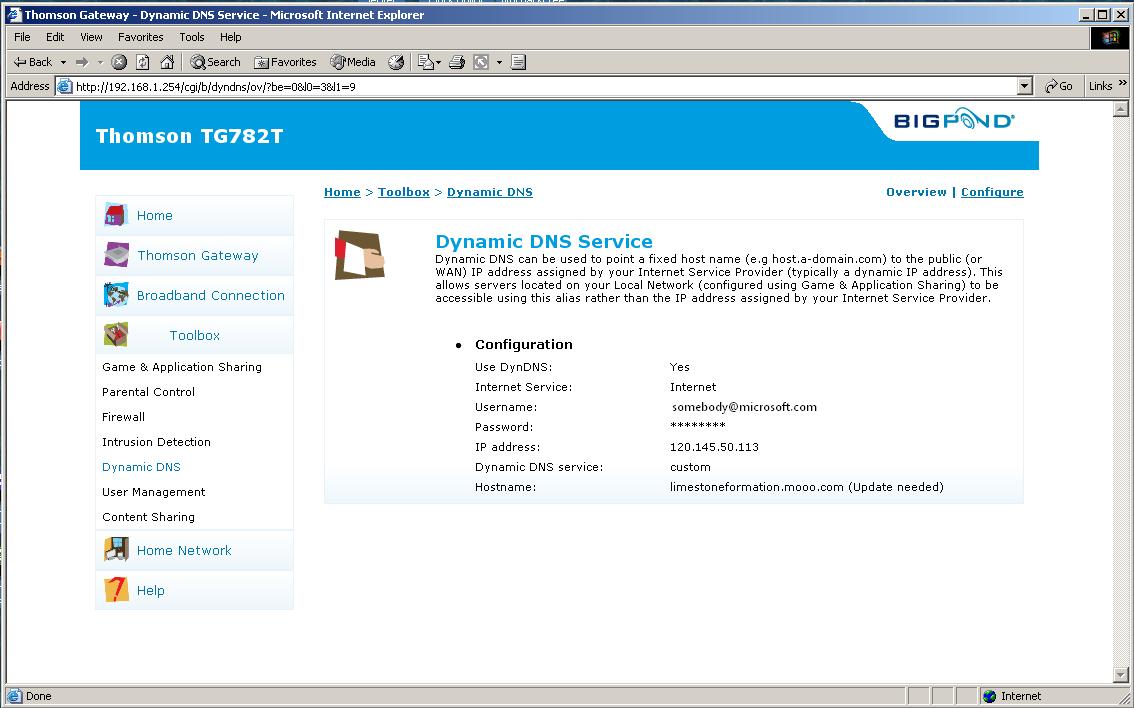
18th October, 2015: Uh-Oh!
I wouldn't be lying if I said that something has gone seriously wrong with the Webserver as of late. Thankfully, I keep a recent "saved state" of the VirtualMachine backed up to preserve my uptimes, in case of any major issues that result in 10ft flames.

The first issue I noted was that with uptimes. This is because I allowed a friend access to my network... Remotely. I had to download a custom-made application named "runme.exe." This is turn would "phone home," and allow the *nix application known as "Armitage" to see my computers, and then connect to other machines, using some known exploits and various commands I have no understanding of.
As I was reading some older blog posts this evening before moving some to the Blog Archive, I remembered I had noted HTTPS connection issues under Windows 2000 and IE6, SP1. It turns out this is caused by the SSL or TLS layers using the older SHA-1 encryption method. If you switch this off, it may or may not work. This feature can be turned off under Windows XP, although I think the issue still presents itself every so often. (MSFN Link A, Link B)
Using IE5.5 apparently solves this issue.
Getting onto my favourite topic: WEBSERVERS!
I must ask, however... Can you blame me for NOT liking them at present?
Rather unfortunately, a power outage took out the server and thus the virtual machine running within (the webserver). It turns out you can't "just restore" from a saved virtual machine file, unless you like Blue Screens of Death. Yeah - I found out the hard way, with 200 days of uptime. *Inserts very angry emoji right here*.


This also lead to me finding out the Webserver's main "access" user account had corrupted itself some time during those intervening 200 days. *Inserts another very angry emoji right here*
Nevertheless, the show MUST go on! Thus the Webserver is still happily chugging away, as is the Server itself - which recently scared me with the Parity drive in my RAID-1 array, once again, orphaning itself. Thankfully, it turns out the RAID card had deseated itself somehow (I assume the worker ants, spiders and other assorted dead insects and arachnids worked some magic). The RAID array subsequently rebuilt itself without any qualms and things are proceeding quite nicely.
For the record, my boot drive now has over 45,000hrs on it. Lets see how long it can hold the Sea behinds it's Gates - *cringes at the bad pun he just made.*
Unfortunately, I did spy what appeared to potentially be a bloated or popped capacitor. There was grey stuff on top and the top did appear bulged. However, given the amount of bugs that get into the Server, it could just be their "leavings," for lack of a worse way to put it.
As I said before, the show MUST go on. Therefore, contrary to what had been suggested prior, my Webserver WILL NOT be going offline. Instead, it will be mirrored somehwere within the realms of the ever-Ghostly, GREYGHOST. (Does it still sound scary? Good). I must say, I am exceedingly grateful to the Webmaster over there for lending his server space (whether or not it is challenged for space).
At present, I doubt that arrangements will be made to accomodate modifications to the content this resource contains. I guess we'll see how things turn out.
8th January, 2016: New Year!
Once again, another year has passed and thus 2016 is now here.
Recently, I tackled the replacement of the Valve Cover Gasket on my 1993 BMW - as this was seemingly original at just over 200,000km (124,274 miles) and had progressed from a "weep" some 30,000km (18k miles) ago to "enough to leak onto the exhaust, transmission, oil pan and everywhere else in the engine bay" status.
The kit to accomplish this replacement was purchased from US firm "PelicanParts," and despite difference in the exchange rate and shipping and gouging - worked out better than local options which didn't really exist online.
This job is easily within the reach of the DIY'er and you can find such a guide explaining the process HERE.
Unfortunately, in this process I found my coil-boots (as the BMW uses ignition-coil-on-plug design) are just beginning to split, and the plug wells they live in were filled with oil, due to the afformentioned VCG failure. Despite having their operation seriously hindered by maybe 1/4 qt. of oil, the car still ran and very good at that (with a slight smell of oil to it, no doubt).
All of this mess was cleaned up, and the new gaskets fitted (with a dab of RTV on the rear halfmoons and at the front of the cylinder head) along with new rubber plugs for each of the 15 bolts used to secure the cover to the M50 inline-6 engine. I have to say, with 21 or so 'vacuum leaks' fixed, the engine runs smoother. Removing the oil cap now produces a noticeable change in engine running. Startups are quicker and don't have the engine briefly "putter" to life.
I also cleaned the valve cover itself with some Kerosense, as some flaky sludge-like material was building up in areas where oil is not circulated very well (above the intake cams, which are covered). This flaky stuff was loose enough that just touching it was enough to remove it, so I wasn't keen to replace the cover without removing this first - as it could potentially find its way into an oil galley and cause hell.
Up next is replacement of the PCV/CCV setup - the earlier M50 engines have two breather hoses, one for the idle control valve and one for the main intake boot. Later variants (M52) use a Cyclonic/Centrifugal Separator (the CCV) for emissions reasons that block up with oil sludge and can hydrolock the engine or fog for mosquitos if left unchecked. Thankfully I have the former, so replacing these two brittle and leaky hoses will be a cinch.
Also slated for replacement are the coil boots and the spark plugs. Both are very cheap, and ought to be done given they spent time (probably a long time) immersed in a mixture of Mobil, Shell and Penrite oils(!)
Photos linked of the Cams: Front (Cyl. 3/2/1), Rear (6/5/4). Description implies the cylinder numbers from the left of pic to right, Rearmost cylinder is #6, Cylinder clostest to the front is #1.
As you can see, I had not removed the old gaskets at the time of photography. The main gasket was pretty brittle and needed some encouragement to be removed. The gaskets for the spark plug wells weren't flash at all and had hardened significantly.
Its worth noting this car has ALWAYS used the BMW "by the lights" service interval, which is anywhere up to 12,000km or 7,500 miles.
In 1993, this mean conventional oils (API SG, but preferably CCMC-G4 or CCMC-G5 {ACEA forerunner} by 1996, semi-synthetic oils (BMW Special Oils approved, CCMC approved) before fully synthetic oils were "permitted" by BMW in 1998 with their "LongLife approved oils," which are ACEA A3/B3 or A3/B4.
I have used synthetic products since the ownership of this vehicle, two shorter intervals (what it arrived with, and Shell Rotella for 3000 miles/5000km) and one long run on Mobil 1 (BMW interval of '93).
Note the message below is somewhat outmoded as of 12/01! Please read the blog post from the 12th of January for some more details.
Seeing as I'm here now, its high time that I mention this resource will go offline indefinitely from around the 10th of Februrary, due to relocation. Whether it comes back hosted in the current fashion is questionable:
As the internet connection will not be under my charge, but rather someone else. I may consider an additional connection for me, but may negotiate to have the server hosted elsewhere.
Due to the fact this is a major disruption to this site - the notice has been put in place of the site Index for now - obviously with navigation choices to proceed to the site as usual.
As the internet connection will not be under my charge, but rather someone else. I may consider an additional connection for me, but may negotiate to have the server hosted elsewhere.
Due to the fact this is a major disruption to this site - the notice has been put in place of the site Index for now - obviously with navigation choices to proceed to the site as usual.
22nd December, 2015: No Worries at Present
The Webserver appears to be working properly still.
I would like to warn those reading that I *DO* frequently peruse the Webserver logs. I record IP, User Agent, Date, Time and what was requested. While this isn't relevant for normal people, I'd like to make it clear that any attempts to compromise this resource - even if they are general 'attacks' on PHP software and the like (which isn't installed anyway), WILL result in me checking Whois? information on the IP address and contacting the ISP responsible.
Just recently I had to contact Gandi in France. They are the only ISP thus far that has returned a courtesy email explaining their team had actively viewed the abuse report and would take further action as necessary.
What I've also done is added support for "HTCPCP/1.0." This is the famous Hyper-Text-Coffee-Pot-Control-Protocol. No coffee pots have been fitted to this Webserver, obviously out of concern for the security risk of too many people trying to test support for this feature, and flooding the server with coffee. Obviously, computers, liquids and the powders that make them do not mix - EVER... I mean, do you KNOW how hard it is just to blend a HP desktop? I can't even get the thing to dissolve in water - nevermind with coffee grounds!
You can test the preliminary support for HTCPCP/1.0 on this server by visitng the following links:
TEA COFFEE
19th October, 2015: Stuff is Working... Sort-Of
"How hard can it be?"
I can't complain that much, as FreeDNS Update at least appears to be working. When your IP address is some sort of HTML code and URL, though, one wonders!

With help from another guide, (Its Right Here), I was able to set up my Thomson Modem/Gateway/Router "thing" that Telstra provides to do the Dynamic DNS updating. This requires Telnet - a Windows utility installed in XP and prior, or the Command Prompt software, which is not installed by default in Windows Vista and above - Search Google yourself to figure this out.
Anyway, the modem will run this process hourly, with FreeDNS in a "backup" position of only once per day. Time will tell if this actually ends up working or not... If memory serves correct, this actually didn't end up working previously.
18th October, 2015: Uh-Oh!
I wouldn't be lying if I said that something has gone seriously wrong with the Webserver as of late. Thankfully, I keep a recent "saved state" of the VirtualMachine backed up to preserve my uptimes, in case of any major issues that result in 10ft flames.

The first issue I noted was that with uptimes. This is because I allowed a friend access to my network... Remotely. I had to download a custom-made application named "runme.exe." This is turn would "phone home," and allow the *nix application known as "Armitage" to see my computers, and then connect to other machines, using some known exploits and various commands I have no understanding of.
I
played a cruel trick by "disabling" the virtual network adapter -
which, of course, destroyed the uptime figure it displayed. I am unsure
what effect this will have on Netcraft's own reporting
of this site, but if it does, then that is your explanation. I will try
to keep a proper log on the uptime using a Windows XP or later system,
and the "systeminfo /S computername" command in the Command Prompt.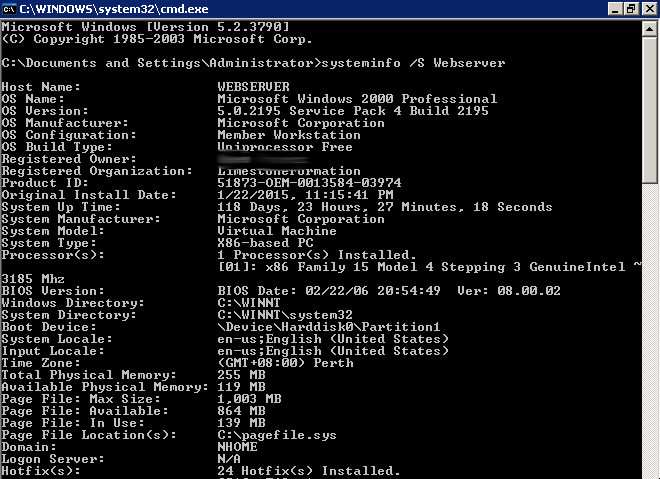
Other commands that will work include the "net statistics server" command also in the Command Prompt. The "statistics since" dialogue is the key to uptimes, and shows the logon date (as in the "Ctrl+Alt+Delete" page).

For those who would consider suggesting I use the Microsoft's "uptime.exe" tool, yes, I have considered it. Unfortunately, it requires .NET Framework v2 or later in order to run. I have not installed that software on the Webserver, and I do not plan on doing so. Mostly because it requires a reboot of Windows. Why would I want to destroy perfectly good uptimes for that?
The other issue?
The Afraid.Org/FreeDNS service provides a number of utilties, for *nix, Windows and Macintosh that will update allow Dynamic DNS to work for people without a static IP address.
Until, well, today, I had been very happen with "Techknowpro's" FreeDNS Update v1.8.4, from Mid-2007 or so. Unfortunately, the logs showed it has been unable to check my external IP since 12am this morning. The program throws two errors:
"IP Detection method could not be determined."
"Are you connected to the Internet?"
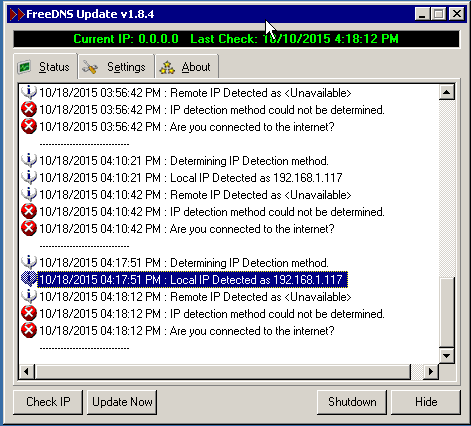
Coincidentally, it seems the Techknowpro website is down. I am unsure whether this utility contacts their own server in order to determine my IP, or if this is somehow related to Windows. I have noted that IE6 has stopped working with sites using HTTPS, and my connection settings have not been altered.
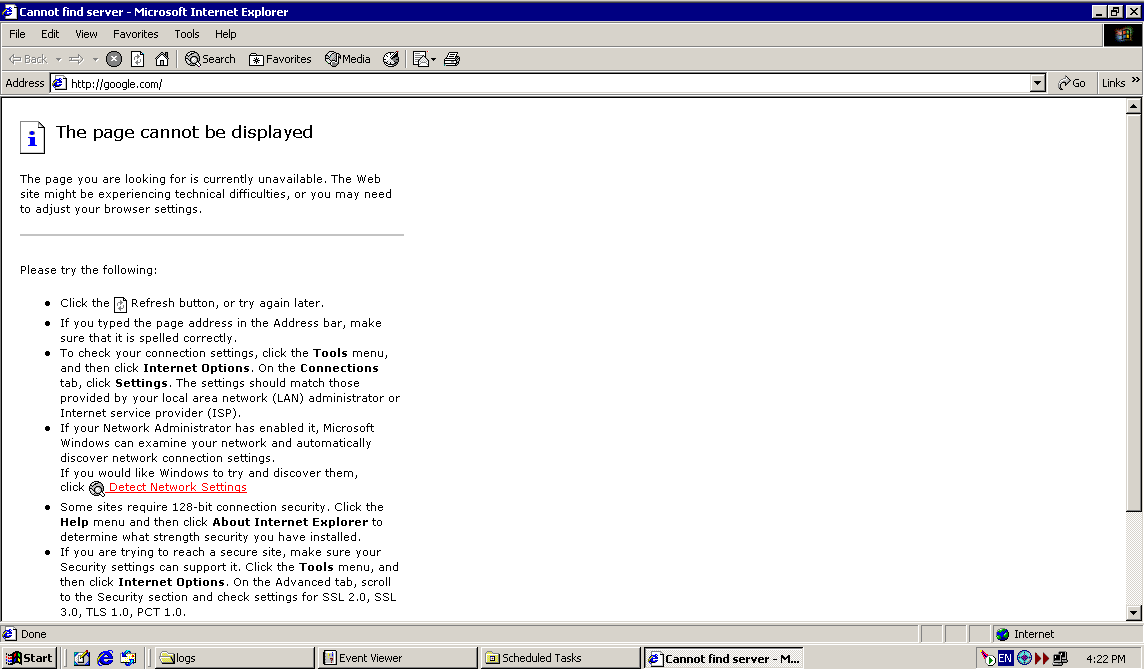

Other commands that will work include the "net statistics server" command also in the Command Prompt. The "statistics since" dialogue is the key to uptimes, and shows the logon date (as in the "Ctrl+Alt+Delete" page).

For those who would consider suggesting I use the Microsoft's "uptime.exe" tool, yes, I have considered it. Unfortunately, it requires .NET Framework v2 or later in order to run. I have not installed that software on the Webserver, and I do not plan on doing so. Mostly because it requires a reboot of Windows. Why would I want to destroy perfectly good uptimes for that?
The other issue?
The Afraid.Org/FreeDNS service provides a number of utilties, for *nix, Windows and Macintosh that will update allow Dynamic DNS to work for people without a static IP address.
Until, well, today, I had been very happen with "Techknowpro's" FreeDNS Update v1.8.4, from Mid-2007 or so. Unfortunately, the logs showed it has been unable to check my external IP since 12am this morning. The program throws two errors:
"IP Detection method could not be determined."
"Are you connected to the Internet?"

Coincidentally, it seems the Techknowpro website is down. I am unsure whether this utility contacts their own server in order to determine my IP, or if this is somehow related to Windows. I have noted that IE6 has stopped working with sites using HTTPS, and my connection settings have not been altered.
